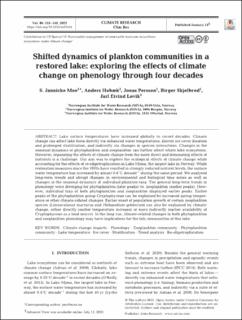| dc.contributor.author | Moe, S. Jannicke | |
| dc.contributor.author | Hobæk, Anders | |
| dc.contributor.author | Persson, Jonas | |
| dc.contributor.author | Skjelbred, Birger | |
| dc.contributor.author | Løvik, Jarl Eivind | |
| dc.date.accessioned | 2023-03-23T13:29:54Z | |
| dc.date.available | 2023-03-23T13:29:54Z | |
| dc.date.created | 2022-06-13T10:38:00Z | |
| dc.date.issued | 2022 | |
| dc.identifier.citation | Climate Research (CR). 2022, 86 125-143. | en_US |
| dc.identifier.issn | 0936-577X | |
| dc.identifier.uri | https://hdl.handle.net/11250/3060171 | |
| dc.description.abstract | Lake surface temperatures have increased globally in recent decades. Climate change can affect lake biota directly via enhanced water temperatures, shorter ice cover duration and prolonged stratification, and indirectly via changes in species interactions. Changes in the seasonal dynamics of phytoplankton and zooplankton can further affect whole lake ecosystems. However, separating the effects of climate change from the more direct and dominating effects of nutrients is a challenge. Our aim was to explore the ecological effects of climate change while accounting for the effects of re-oligotrophication in Lake Mjøsa, the largest lake in Norway. While restoration measures since the 1970s have resulted in strongly reduced nutrient levels, the surface water temperature has increased by almost 0.4°C decade-1 during the same period. We analysed long-term trends and abrupt changes in environmental and biological time series as well as changes in the seasonal dynamics of individual plankton taxa. The general long-term trends in phenology were diverging for phytoplankton (later peaks) vs. zooplankton (earlier peaks). However, individual taxa of both phytoplankton and zooplankton displayed earlier peaks. Earlier peaks of the phytoplankton group Cryptophyceae can be explained by increased spring temperature or other climate-related changes. Earlier onset of population growth of certain zooplankton species (Limnocalanus macrurus and Holopedium gibberum) can also be explained by climatic change, either directly (earlier temperature increase) or more indirectly (earlier availability of Cryptophyceae as a food source). In the long run, climate-related changes in both phytoplankton and zooplankton phenology may have implications for the fish communities of this lake. | en_US |
| dc.language.iso | eng | en_US |
| dc.publisher | Inter-Research | en_US |
| dc.rights | Navngivelse 4.0 Internasjonal | * |
| dc.rights.uri | http://creativecommons.org/licenses/by/4.0/deed.no | * |
| dc.title | Shifted dynamics of plankton communities in a restored lake: exploring the effects of climate change on phenology through four decades | en_US |
| dc.type | Peer reviewed | en_US |
| dc.type | Journal article | en_US |
| dc.description.version | publishedVersion | en_US |
| dc.rights.holder | © 2022 The Authors | en_US |
| dc.source.pagenumber | 125-143 | en_US |
| dc.source.volume | 86 | en_US |
| dc.source.journal | Climate Research (CR) | en_US |
| dc.identifier.doi | 10.3354/cr01654 | |
| dc.identifier.cristin | 2031309 | |
| cristin.ispublished | true | |
| cristin.fulltext | original | |
| cristin.qualitycode | 1 | |

